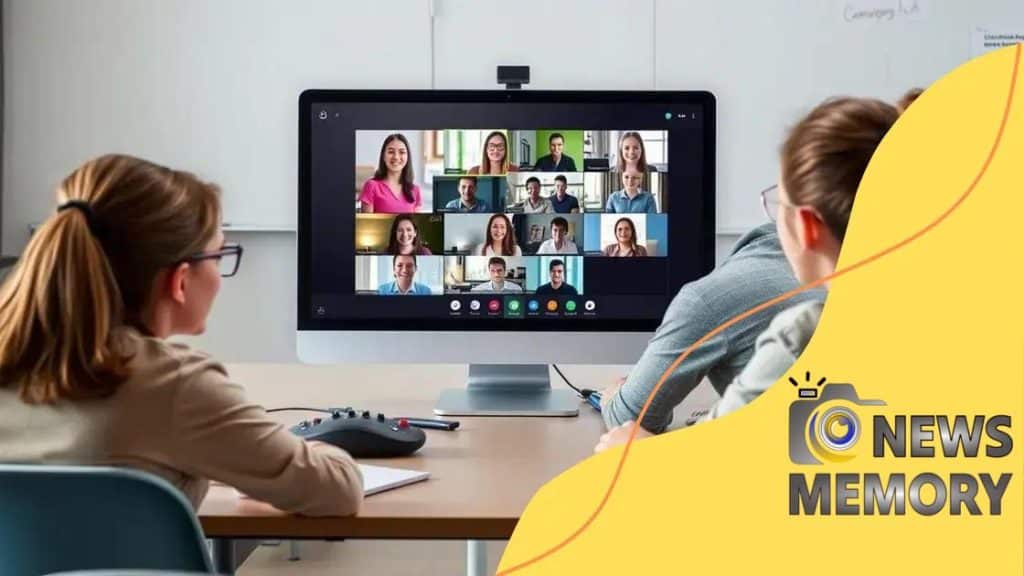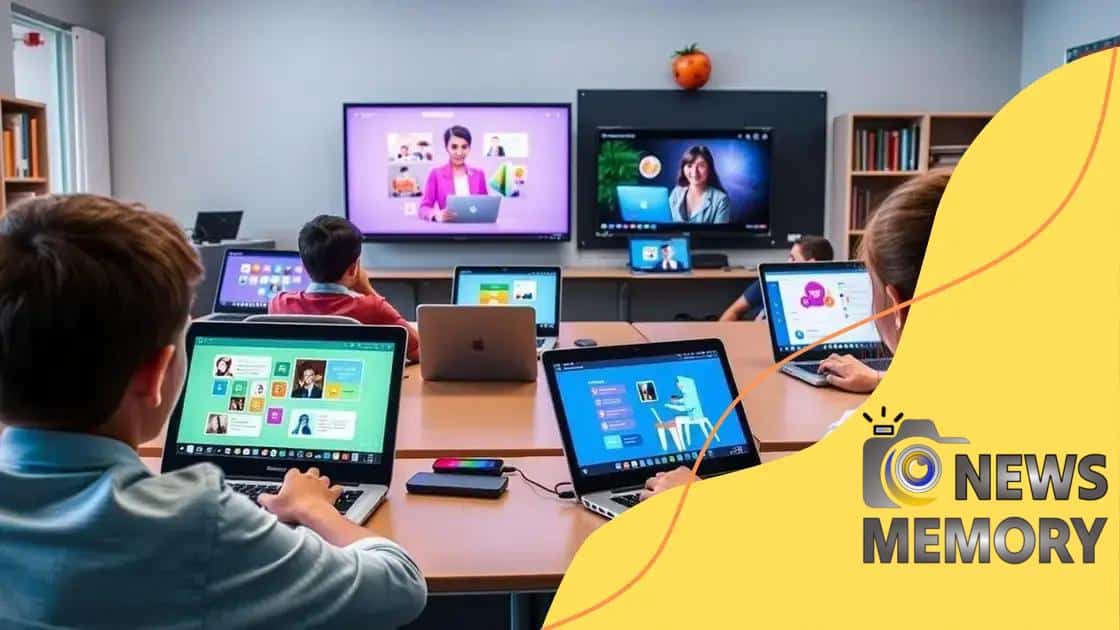The impact of virtual classrooms on student collaboration

The impact of virtual classrooms on student collaboration includes enhanced communication, diverse interactions, and accessibility, all of which foster a more engaging and inclusive learning environment.
The impact of virtual classrooms on student collaboration is significant, transforming how students engage and work together. Have you ever wondered how these platforms change the dynamics of learning? Let’s dive in!
Understanding virtual classrooms and their structure
In today’s digital age, understanding virtual classrooms and their structure is essential for both educators and students. These online environments offer unique opportunities for collaboration and learning.
Virtual classrooms typically consist of various digital tools and platforms that facilitate communication, interaction, and content delivery. Using a combination of video conferencing software, discussion boards, and collaborative tools, students are able to engage with their peers and instructors in real time.
Key Components of Virtual Classrooms
Several essential elements make up an effective virtual classroom:
- Video Conferencing: This allows for real-time sessions where students can participate actively.
- Learning Management Systems (LMS): Platforms such as Canvas or Moodle help organize course materials and assignments.
- Interactive Tools: Applications like Google Docs or Padlet enable students to collaborate on projects seamlessly.
- Assessment Tools: Tools for quizzes and feedback help track student progress.
An integral aspect of these environments is the focus on community building. In a physical classroom, students naturally interact, but in a virtual space, educators must foster this sense of belonging. This can be achieved through group activities, breakout rooms during live sessions, and encouraging online discussions.
Moreover, accessibility is a major factor. Virtual classrooms break geographical barriers, allowing students from diverse backgrounds to collaborate. This diversity enriches the learning experience, offering different perspectives and ideas. However, it’s also important to address challenges such as technology access and digital literacy among students.
Benefits of Understanding Virtual Classrooms
By grasping the structure and function of virtual classrooms, students and educators can maximize their potential:
- Increased Engagement: Interactive materials keep students interested.
- Flexible Learning: Students can learn at their own pace.
- Broader Networking Opportunities: Connecting with peers globally enhances learning.
- Enhanced Resource Access: A wealth of online resources are available for research.
Overall, the design and networking possibilities in virtual classrooms create a dynamic learning environment. Understanding these components empowers everyone involved to adapt and thrive in a digital education landscape.
Benefits for student collaboration
Understanding the benefits for student collaboration in virtual classrooms is crucial for enhancing the learning experience. Collaborative learning helps students connect and learn from one another.
When students work together, they share ideas, solve problems, and gain different perspectives. This dynamic interaction often leads to deeper understanding and retention of information.
Key Benefits of Collaboration
There are several key benefits that emerge when students collaborate:
- Improved Communication Skills: Engaging with peers helps students articulate their thoughts clearly.
- Increased Motivation: Working in groups can boost motivation as students encourage each other.
- Enhanced Critical Thinking: Discussions and group work promote analytical skills as students challenge each other’s viewpoints.
- Greater Creativity: Collaboration often leads to innovative ideas, as diverse perspectives inspire unique solutions.
Furthermore, virtual collaboration eliminates physical barriers, allowing diverse teams to form. Students from different backgrounds bring varied experiences and knowledge, enriching dialogues and project outcomes.
Technology plays a pivotal role in facilitating these collaborative efforts. From platforms like Zoom to shared documents in Google Workspace, students can engage effortlessly, making it easy to brainstorm and contribute to each other’s work.
Additionally, regular collaboration fosters a sense of community. Students can build relationships, develop teamwork skills, and create lasting connections that extend beyond the classroom. This digital camaraderie helps students feel less isolated in their learning journey.
Long-Term Advantages
The benefits of collaboration extend beyond academic achievement. Students who work well with others are better prepared for real-world challenges, as teamwork is a vital skill in any career. They learn to respect diverse opinions and develop the ability to resolve conflicts amicably, preparing them for future workplaces.
In summary, the benefits of student collaboration in virtual classrooms are vast. By promoting teamwork and shared learning experiences, educators can create a rich and engaging educational environment.
Tools enhancing collaboration in virtual settings

The right tools enhancing collaboration in virtual settings can transform the learning experience. Students today have access to various digital platforms that facilitate teamwork and interaction, making learning more engaging.
Among the most popular tools are video conferencing applications. These platforms allow students to participate in live discussions, share screens, and work on projects together in real time.
Essential Tools for Collaboration
Several tools stand out for promoting effective collaboration:
- Google Workspace: Offers a suite of tools like Docs, Sheets, and Slides, perfect for group projects.
- Microsoft Teams: Combines chat, video calls, and file sharing in one platform, ideal for classroom communication.
- Slack: A messaging app designed for team collaboration that helps streamline conversations and project updates.
- Trello: A project management tool that helps teams organize tasks visually.
These tools not only enhance collaboration but also improve communication skills among students. As they navigate these platforms, they learn to express their ideas more clearly and listen actively to their peers.
In addition to communication tools, interactive platforms allow students to create engaging content. For example, tools like Padlet and Miro encourage brainstorming and collaborative mind mapping, making group work fun and creative. By using these resources, students can collectively brainstorm ideas and visualize their thoughts.
Adapting to Different Learning Styles
Another advantage of using these collaborative tools is their ability to cater to different learning styles. Some students may prefer visual tools, while others thrive in collaborative discussions. By incorporating various tools, educators can address the unique needs of their learners.
Additionally, the accessibility of these tools plays a significant role. Many platforms are designed to be user-friendly, which means students can easily navigate them without extensive training. This ease of use helps to maximize participation and ensures that all students can be involved.
Ultimately, the integration of these tools in virtual classrooms promotes a collaborative spirit. It encourages students to work together, developing essential skills for their future academic and professional endeavors.
Challenges faced in virtual collaboration
While virtual collaboration offers many advantages, there are also significant challenges faced in virtual collaboration. Understanding these issues is essential for educators and students to navigate the online learning landscape effectively.
One major challenge is the lack of face-to-face interaction. In a physical classroom, body language and facial expressions play a crucial role in communication. However, in virtual settings, these cues can be missed, leading to misunderstandings among team members.
Common Challenges in Virtual Collaboration
Several challenges often arise during virtual collaboration:
- Technology Issues: Connectivity problems, software glitches, and hardware limitations can disrupt collaboration.
- Time Zone Differences: Students from different regions may struggle to find suitable times for group meetings.
- Distractions at Home: Learning environments at home may not provide the same focus as a classroom.
- Lack of Engagement: Some students may feel isolated or less motivated when working online.
Additionally, varying levels of digital literacy can lead to frustration. Not all students are equally familiar with the tools used for online collaboration, which can hinder their ability to contribute effectively. Educators must be aware of these differences and offer support when needed.
Another challenge is ensuring equal participation. In group settings, some students may dominate discussions while others remain quiet. This imbalance can affect group dynamics and limit the diversity of ideas shared. Encouraging everyone to participate actively requires careful facilitation.
Addressing the Challenges
To address these challenges, educators should foster an inclusive and supportive environment. Creating guidelines for participation can help set expectations for all students, ensuring everyone has a voice. Regular check-ins can also help identify any issues students face.
Moreover, providing training on collaboration tools can enhance students’ confidence and competence. Workshops or tutorials can help bridge the gap for those who may feel less comfortable using technology. Overall, awareness of these challenges is key to making virtual collaboration a positive experience.
Future trends in virtual classrooms
The future trends in virtual classrooms are evolving rapidly as technology advances and education adapts to new demands. Innovations in digital tools are reshaping the way students learn and interact.
One significant trend is the integration of artificial intelligence in educational platforms. AI can personalize learning experiences by analyzing students’ progress and adapting content to meet their unique needs.
Emerging Technologies Influencing Virtual Classrooms
Several technologies are expected to change virtual learning:
- Virtual Reality (VR): VR offers immersive learning experiences, allowing students to explore simulations and environments that enhance understanding.
- Augmented Reality (AR): AR can bring digital elements into the physical world, making lessons more interactive and engaging.
- Gamification: Incorporating game elements into lessons motivates students and makes learning more enjoyable.
- Cloud-based Collaboration Tools: These tools will continue to improve, making it easier for students to work together in real time from different locations.
Furthermore, the focus on social-emotional learning (SEL) is gaining importance. Educators are recognizing that emotional intelligence is key to student success. Programs that promote SEL can help students manage stress and build stronger relationships with their peers.
Continuous professional development for educators is another vital trend. As technology evolves, teachers need ongoing training to effectively utilize new tools and enhance their teaching strategies. Professional development not only improves classroom management but also fosters a culture of innovation.
Blended Learning Models
The blending of online and in-person learning is also a growing trend. Blended learning models provide flexibility, allowing students to choose how they engage with materials. This hybrid approach can cater to various learning styles and can be more effective than traditional methods alone.
As we look ahead, the emphasis will be on creating inclusive virtual classrooms that cater to diverse learning needs. With an increase in online resources and accessibility, all students will have opportunities to succeed.
Overall, the future of virtual classrooms is bright, with trends that enhance learning, promote collaboration, and prepare students for the challenges ahead.
FAQ – Common Questions About Virtual Classrooms
What are the main benefits of virtual classrooms?
Virtual classrooms provide flexibility, accessibility, and opportunities for collaboration among students with diverse backgrounds.
How can technology enhance student collaboration?
Technology facilitates communication and interactions through various tools, such as video conferencing and collaborative platforms.
What challenges do students face in virtual classrooms?
Common challenges include lack of face-to-face interaction, technology issues, and distractions at home.
What trends are shaping the future of virtual classrooms?
Emerging trends include AI integration, virtual and augmented reality, and a focus on social-emotional learning.





